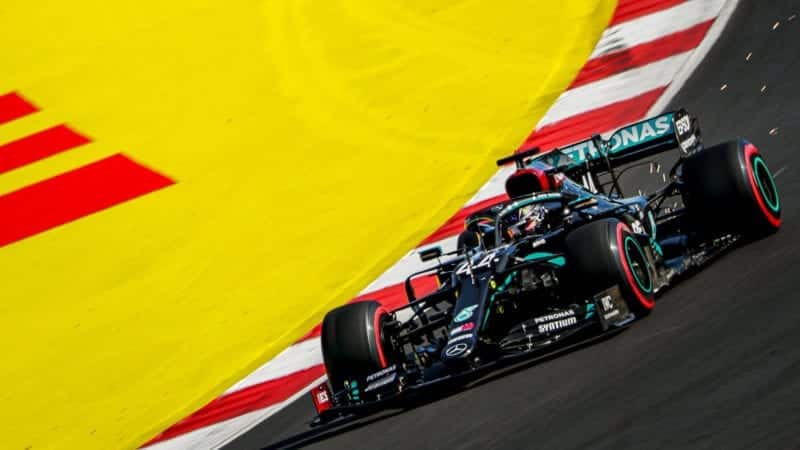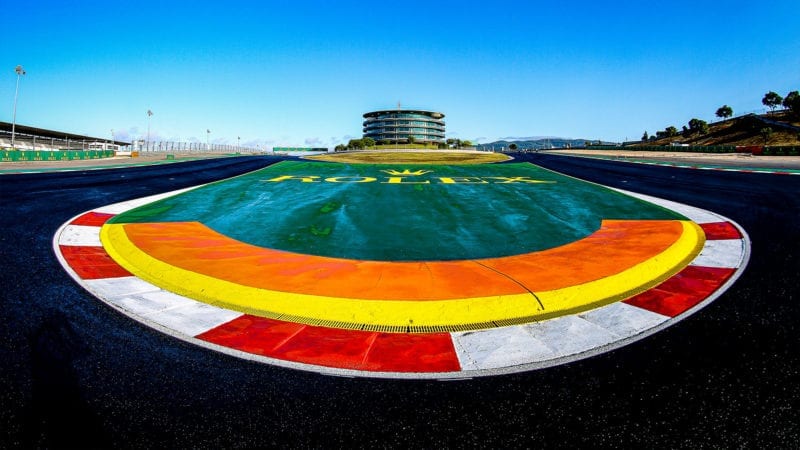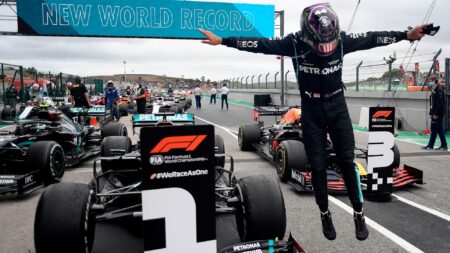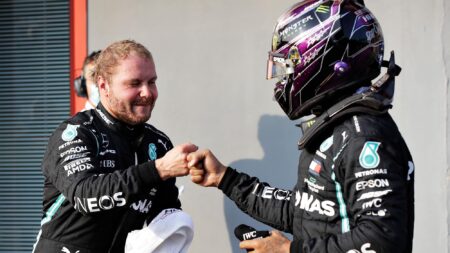The harder the compound, the less likely it will be to overheat. Without the thermal degradation mechanism, it won’t lose much performance with wear. It will just suddenly be out of tread – like what happened at the end of the British Grand Prix, with tyres collapsing. It was to avoid such a scenario that these compounds were selected. The choice was probably about right too – for even the C3 was quite seriously graining its front left throughout the weekend. Anything softer would have grained even more. But that front-left could be nursed through the graining phase – about 20 laps – and when you came out the other side it would be very little slower than when it was new. So long stints – and therefore one-stop – were still feasible.
Even the medium (the C2) grained a little. But not so much that you couldn’t lean on it and force a hard pace. Turned out that made it much the better tyre on Sunday. It may even have been better on Saturday – as was suggested by the Mercedes drivers ditching their softs for the second Q3 runs and using mediums to better their times in locking out the front row, Hamilton ahead.
Lack of Friday FP2 running
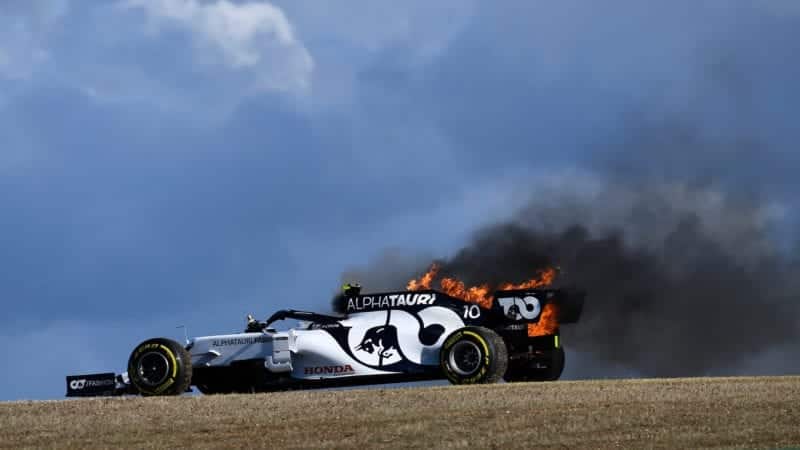
Gasly’s burning AlphaTauri sent teams’ free practice plans up in smoke
Grand Prix Photo
Pirelli locked out the first half-hour of the 1.5 hours Friday afternoon practice session for testing its prototype 2021 tyres. Every team had to run them in order to build up Pirelli’s data banks – and the teams were not told which compound they were.
The remaining hour was then interrupted by two red flags. One to retrieve Pierre Gasly’s fire-damaged AlphaTauri, another to clear the mess from a Lance Stroll/Max Verstappen collision. So no-one had done a long run. So no-one knew which was actually the better race tyre – the C3 or the C2. Or even how the C1 hard compared.
Team tyre choices
Most feared the C1 was just too slow. Mercedes didn’t. It reckoned the graining C3 would be the problem tyre and that the W11’s ample downforce could get the C1 working. So it planned around the C2 medium as the foundation of its strategy – qualify in Q2 on it so as to get it for the first stint, confident it would run quick for 40 laps or so. With the hard good enough to then get to the flag at 66. It might be a bit slow to get up to temperature, but the boys in the cockpit could deal with that. They were sure of it.
Red Bull really didn’t trust that hard, though. They reckoned the soft would be as quick, even if needing a little more nursing, than the medium. They also reckoned this was going to be a two-stop, as surely everyone’s graining left-front would quickly wear and enforce short stints.
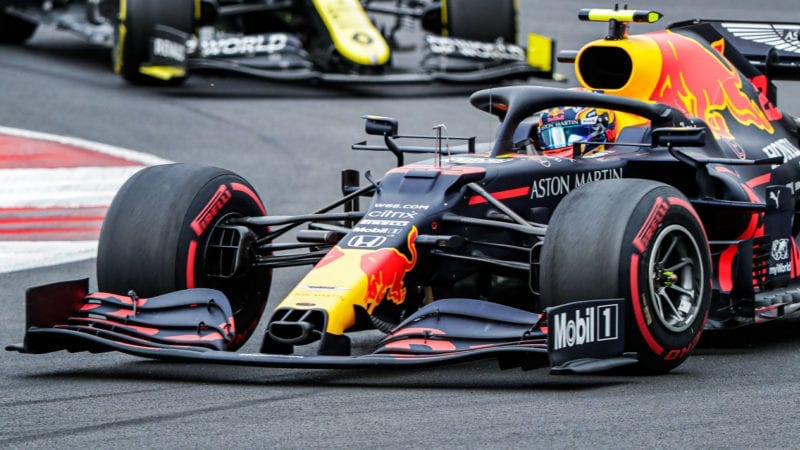
Red-walled soft tyres were the wrong choice in the race
Paulo Maria / DPPI
Mercedes called it right, Red Bull didn’t. The wear of the soft wasn’t that bad at the speeds the graining imposed and one-stop was heavily favoured. Ferrari had a car quick enough (on phase three of its recent three-phase aero update) to adopt the Mercedes strategy of mediums in Q2. Sebastian Vettel could get no tune from it, just couldn’t bring them up to temperature and qualified 15th. But Leclerc had no trouble, got through to Q3 and proceeded to drive a stunning lap there that put him fourth on the grid, only 0.1sec shy of Verstappen. And on a better tyre strategy.
The soft just didn’t work very well. It retained its performance after the graining phase, sure. But it could not be pushed as hard as the medium. It would just grain the left-front away if you tried – which would have allowed the one-stop cars would be able to save a pit stop (about 24sec time loss) over you.
How it Played Out
So with slow-to-warm mediums on the Mercs, faster-to-warm softs on most of the others, the performance order was all jumbled up in the first few laps. Carlos Sainz and Kimi Räikkönen had instant temperature and initially starred. Sainz had his McLaren up to second place behind Bottas by turn 10 of the opening lap and was into the lead a lap later. Räikkönen vaulted his Alfa Romeo from 16th to sixth within the first seven corners. The Red Bulls weren’t switching on the softs as well as the McLaren or Alfa – and Verstappen briefly had Raikkonen snapping at his heels.
From P16 to P6 😎
An amazing start for Kimi Raikkonen at Portimao 🚀#PortugueseGP 🇵🇹 #F1 pic.twitter.com/cRneQ4dw2O
— Formula 1 (@F1) October 25, 2020
But as quick as the softs came up to temperature, so they began to grain. This was about four laps in – just as the mediums were finally coming up to temperature. So normal service was resumed – the Mercs moved back up to the front, Bottas – who’d got front tyre temperature faster than Hamilton and passed him on the first lap – still ahead. Verstappen was up to third but on his graining softs was being left behind by the Mercedes pair. Räikkönen too slowly returned to reality and dropped back.
Leclerc, on his mediums, quickly got up to fourth, kept Verstappen in sight, ran 11 laps longer and rejoined only 10sec behind. But the Red Bull was working much better in the second stint, now on the mediums (just underlining that it should have had them on in the first stint). The hard-tyred Leclerc thereafter consolidated a genuine on-merit fourth place, actually Ferrari’s most competitive performance of the season.
